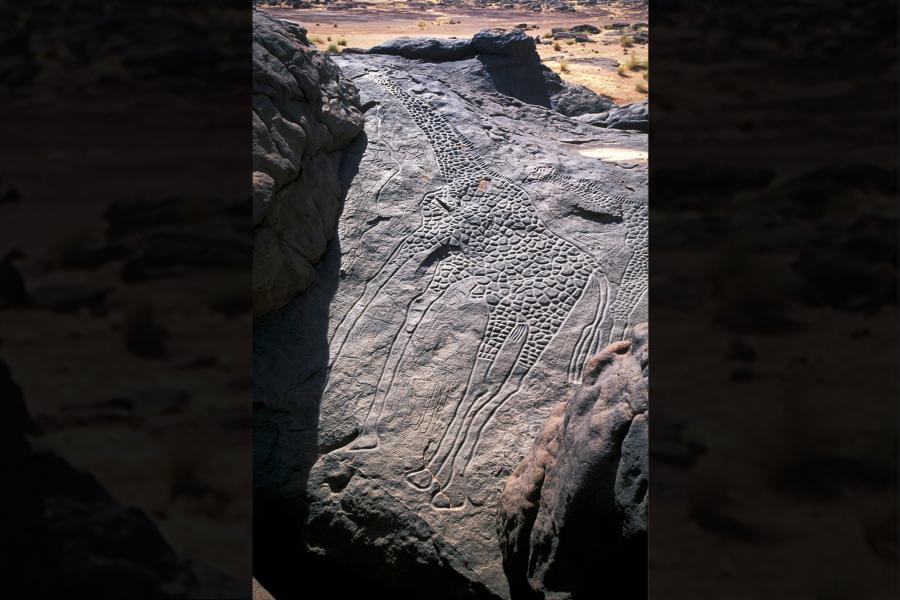What emotions do these images of animals evoke in you?


Giraffe
'Gobero, Tenere desert, Sahara, Niger. UNESCO World Heritage Site'
c8,000 BCE
unknown/unknowable
An ancient life-sized carving of a giraffe on a rocky outcrop in Mali, deep in the Sahara Desert.
More about this image-
Bright emotions
-
Not at all Extremely
-
-
Quiet emotions
-
Not at all Extremely
-
-
Heavy emotions
-
Not at all Extremely
-
-
Sombre emotions
-
Not at all Extremely
-
Species: Giraffe (subspecies unknown/unknowable)
Location and habitat: Africa; Eastern, Middle, Southern and Western
Conservation Status: Vulnerabl, IUCN Red List

Compare yourself to others
Choose different variables below, and see the patterns of response reflected in the circle of emotion above. Your responses are the coloured wedges. Others' responses are averaged in the spider graph of lines and dots.

Title: 'Gobero, Tenere desert, Sahara, Niger. UNESCO World Heritage Site'
Creator: unknown/unknowable
Date: c8,000 BCE
Medium: Engraving
Photographer: Frans Lemmens, 20/9/2004
Copyright: Via Alamy
Deep in the Sahara Desert, current day Mali, lies a rocky outcrop that features the unmistakable image of life-sized giraffes carved into it. These carvings were made around 10,000 years old, likely by the Kiffian people, ancient inhabitants of the Sahara Desert during its humid period. Needless to say, 10,000 years is a very long time, before the Bronze Age, hence there were no metal tools available to the creators, with the image spending much time and energy to scrape and smooth the rock, with various depths and create perhaps the world's largest rock art petroglyph. The image, which depicts a pair of giraffes, the larger male measuring 5.4 metres high, and a line leading from the animal's head to a human. The carving was first 'discovered' by Europeans in 1987, though the ancient site has been long in the custodianship of the local Tuareg community. The site is near the historic city of Agadez, a place now bustling with migrants and refugees en route north. It is also home to a large US military base from which hunter-killer drones are frequently launched. Since becoming known to global publics, the carving has deteriorated owing to in/voluntary destruction by visitors. In the year 2000, the site declared in the top one-hundred Most Endangered Sites by World Monument Watch.
Not only is this image endangered, but the species it represents it too at risk. Today, there are less than 100,000 giraffes in the wild, down from around 150,000 a generation ago. They have disappeared entirely from former habitats, such as Mali and are considered 'vulnerable', with habitat destruction, slaughter for bushmeat, and drought being the primary threats -- all directly mapping onto human activity. Within the overarching 'giraffe' category, there is considerable variation in the level of threat according to its sub/species (depending on one's taxominic framework). Some are not considered endangered, like the Angolan and Rothschild giraffes, through to others being considered critically endangered, like the Nubian and Kordofan giraffes.
As all good kindergarten students know, Giraffes are not only the world's tallest living animals, but also thoroughly intriguing creatures. Their great height, lanky build, elegantly spotted coats, combine with the sensuality of their luscious lips, large eyes, luxuriously eyelashes, heads a toped with horns like doorknobs covered in velvet. All of this adds up to a thoroughly charismatic creature that has, since before the times of the ancient Kiffian carvers, been a rich source of fascination, with their images being widespread across many cultures. A captive giraffe was presented to Julius Caesar in 46BCE -- the "cameleopard" as they called it -- and in 1414 one taken from Kenya by General Zheng He all the way to Beijing to live out its days in a Ming dynasty zoo. The legacy of fascination goes all the way through to Sophie the Giraffe, a popular rubber teething toy. Made in France, and very popular there -- more giraffe teethers are sold than babies born -- with Amazon's warehouses sending off Sophies across the world. This touches on how crucial animals, and their images, are to the making of young subjectivities, with a giraffe being an architype of such a phenomena.





